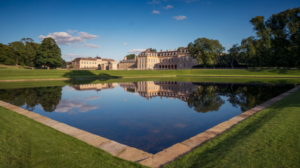Detectives at the English stately home: Discovering Sancho in the Boughton House archives
By: Ellen Valente

Starting off the research project, the idea of Sancho that we had from reading the letters was an almost fictional Sancho – we heard his voice, we could see on a map where he was going, but fleshing out his world was still a work of the imagination.
However, upon visiting Boughton House, guided by the Buccleuch archivist Crispin Powell, we saw first-hand the scale of the prodigious physical spaces that Ignatius Sancho would have occupied and known. There was a collective excitement at the repercussions of Sancho’s position within such a grand house. Most importantly, it consolidated, what once was an inkling, of Sancho’s centrality in eighteenth-century society.
Much of the evidence we had encountered so far was through various digital sources and a recent edition of Vincent Caretta’s letters. Yet, all this changed upon arriving at the archives in Kettering… Laid out, upon the table like a portal into an accountant of a different world, was original documentation with Sancho’s name. Powell talked us through the archives where there were not only receipts of employment, but proof the Montague clan had brought ‘Sancho’s music’, an annuity in the will of the Duchess of Queensbury, the bills for the furnishings of his room in Boughton House and, rather excitingly, Windsor Palace.
The significance of this, seeing his presence occupying the archival evidence, answered questions about the significance of Sancho’s role in the Boughton house. He was not simply an employer, but a well looked after employer, and arguably a friend. This is established by the Montagu family’s wish to furnish Sancho comfortably and support him in all his endeavours. This was concrete proof of the potential for, what can look like, miscellaneous data in connecting fragments of a much bigger narrative. Sancho’s role and the attitude the family had towards him began to paint in our minds – what exactly did eighteenth-century London look like? Specifically, what did it look like for the Black Londoners? The answer that Sancho is offering us is a society of integration and comradery – with the potential for more stories lurking around ready to be told (perhaps in the very same Boughton House archives.)